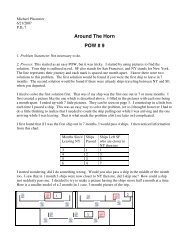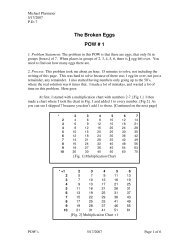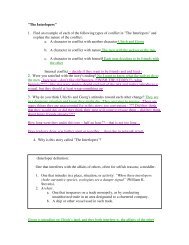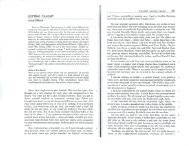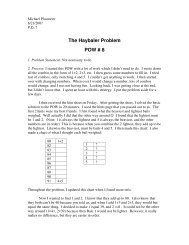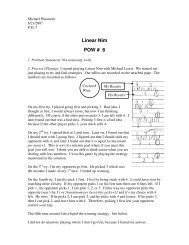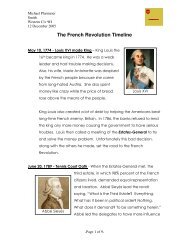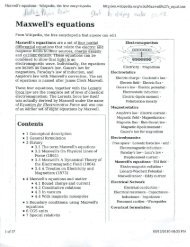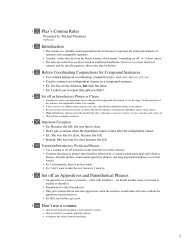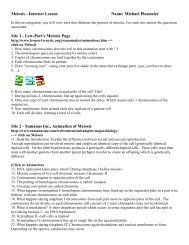- Page 1 and 2: Problem 5: Inductor An inductor con
- Page 3: Problem 6: Trying to open the switc
- Page 7 and 8: The greatest potential difference a
- Page 9 and 10: PRS:Loop The magnetic field through
- Page 11 and 12: PRS: Stopping a Motor Consider a mo
- Page 13 and 14: If you increase the resistance in t
- Page 15 and 16: Class 31: Outline Hour 1: Concept R
- Page 17 and 18: PRS Questions: Faraday's & Lenz's L
- Page 19 and 20: Maxwell's Equations [jJE.dA = Q. ,
- Page 21 and 22: PRS Questions: Inductors & Circuits
- Page 23 and 24: PRS: RC Circuit 0 An uncharged capa
- Page 25 and 26: PRS: LC Circuit Consider the LC cir
- Page 27 and 28: Plot I, V's vs. Time ." Resonance I
- Page 29 and 30: ill PRS: Leading or Lagging? The gr
- Page 31 and 32: PRS Questions: Poynting Vector Clas
- Page 33 and 34: Rtv'(~\V Se76'O') ~->t 3 Dorfll IJ
- Page 35 and 36: " dr~wl 'J ~ 6 ods -Vlo 1- f lfd h4
- Page 37 and 38: ~ I\ ~ h 5(1\11 II r trs At o S: Cr
- Page 39 and 40: - f\J 5~ B 'd~ loop 1 fi ~ ~ tl-trP
- Page 41 and 42: for 6(J'; d(lo;J ncA,Ie.. V\ bJ- Ir
- Page 43 and 44: t ftJ{ :~"y ; Lao' :'> ChUAa:AJ flv
- Page 45 and 46: @ I~ E f i~ ~ Yes (' /0.. F -J~ =-
- Page 47 and 48: Co thro~ ~ 0- fvl) c tcl e 5o~ er
- Page 49 and 50: [1\ Q 1 -l L I dl ~ 0 " - d I c Q 1
- Page 51 and 52: ----....... (~~i(Aj JI( ) (hv(9Y'~
- Page 53 and 54: , • Problem 1: (25 points) Five C
- Page 55 and 56:
Question 3 (5 points): A circuit co
- Page 57 and 58:
Question 5 (5 points): A coil of wi
- Page 59 and 60:
iii) inside the slab, -d / 2 < z <
- Page 61 and 62:
Problem 3 (25 points) NOTE: YOU MUS
- Page 63 and 64:
(c) What is the total charge Q that
- Page 65 and 66:
(b) What is the self-inductance L o
- Page 67 and 68:
MASSACHUSETTS INSTITUTE OF TECHNOLO
- Page 69 and 70:
Question 3 (5 points): A circuit co
- Page 71 and 72:
Q uestion S (S points): A coil of w
- Page 73 and 74:
Problem 2 (25 points) NOTE: YOU MUS
- Page 75 and 76:
) Make a carefully labeled graph sh
- Page 77 and 78:
(c) What is the total charge Q that
- Page 79 and 80:
So (b) What is the self-inductance
- Page 81 and 82:
~ !hi'> (lo.~ " before ~)(G{Ii" vtf
- Page 83 and 84:
I d "7 ( ~ B cl~ 0- lP ~ ( e 601--
- Page 85 and 86:
Summary of Class 32 8.02 Topics: Ma
- Page 87 and 88:
Hour 1: Class 32: Outline Energy Fl
- Page 89 and 90:
Traveling E & B Waves Wavelength: A
- Page 91 and 92:
Poynting Vector and Intensity Direc
- Page 93 and 94:
(t! ((e.lto VI ~ ~ f") r :~(i 00 .
- Page 95 and 96:
MASSACHUSETTS INSTITUTE OF TECHNOLO
- Page 97 and 98:
MASSACHUSETTS INSTITUTE OF TECHNOLO
- Page 99 and 100:
Summary of Class 33 8.02 sky under
- Page 101 and 102:
PRS I ) - is (U(rh l t/ Vt,t ,,7c1.
- Page 103 and 104:
Generating Electric Dipole Radiatio
- Page 105 and 106:
Spark Gap Generator: An LC Oscillat
- Page 107 and 108:
Spark Gap Antenna Demonstration: An
- Page 109 and 110:
PRS Questions: Angular Distribution
- Page 111 and 112:
Interference Interference: Combinat
- Page 113 and 114:
A Extra Path Length Mi~~oor"'-"" /
- Page 115 and 116:
Two Transmitters Microwave Interfer
- Page 117 and 118:
Group Problem: Lecture Demo We just
- Page 119 and 120:
OBJECTIVES MASSACHUSETTS INSTITUTE
- Page 121 and 122:
Detecting (Receiving) the Radiation
- Page 123 and 124:
IN-LAB ACTIVITIES EXPERIMENTAL SETU
- Page 125 and 126:
IN-LAB ACTIVITIES MEASUREMENTS MASS
- Page 127 and 128:
MASSACHUSETTS INSTITUTE OF TECHNOLO
- Page 129 and 130:
10(1 '+ ,,"or (7 ctboJt-- JeN)", t{
- Page 131 and 132:
l' \ L] (6 ~~ oJ ~1~Jnr~ f o./('o;v
- Page 133 and 134:
lJ> ; r1 () olv+ to "1 ~ Y ~ f yo S
- Page 135 and 136:
,. ~ ,r,ve l i~j X (J ir pM '9 ctti
- Page 137 and 138:
X ~ E l/OV (l{l. ~jt)~b\lj Jf -I- d
- Page 139 and 140:
MASSACHUSETTS INSTITUTE OF TECHNOLO
- Page 141 and 142:
(b) What is the width of the centra
- Page 143 and 144:
Problem 3: Slalldillg Waves The ele
- Page 145 and 146:
(d) If the path difference is 0 = A
- Page 147 and 148:
8.02 MASSACHUSETTS INSTITUTE OF TEC
- Page 149 and 150:
3. Another Way to Measure Hair Side
- Page 151 and 152:
(c) Derive an equation for calculat
- Page 153 and 154:
Problem 3: Siandillg Waves The elec
- Page 155 and 156:
~ ' // r;" E~(( c, (iL&;l' L '>! if
- Page 157 and 158:
- F x, • J!,::=
- Page 159 and 160:
Problem S. Electromaglletic Waves T
- Page 161 and 162:
EI;nt/J...I (x=c) =- c. 6 0 S01 (-w
- Page 163 and 164:
(e) In the double-slit interference
- Page 165 and 166:
v: =- ;3 w7f 2- o • "- 7fT=. R r
- Page 167 and 168:
) What is the total energy stored i
- Page 169 and 170:
-f-6\ «/7,.....-/?' x,d ...... ~ 1
- Page 171 and 172:
Summary of C lass 34 S.02 Topics: E
- Page 173 and 174:
t , l • --"77"--- t 4' ~I P--..!-
- Page 175:
t t I t l"k... t-'e l \ ~ - C v tl
- Page 190 and 191:
When ordinary light is emitted from
- Page 192 and 193:
Question 2: Draw a picture of two t
- Page 194 and 195:
Question 8: Why are the phase sh~ t
- Page 196 and 197:
Question 12: Since the energy of th
- Page 198 and 199:
Summary of Class 35 8.02 Here Ih e
- Page 200 and 201:
Two In-Phase Sources: Geometry I I
- Page 202 and 203:
Intensity Distribution Destructive
- Page 204 and 205:
Coherent monochromatic r . (j 1 t I
- Page 206 and 207:
Experiment 10, Part I: Measure Lase
- Page 208 and 209:
PRS: Lower Limit? _ Using diffracti
- Page 210 and 211:
Two Slit Interference ----- L. ---.
- Page 212 and 213:
APPARATUS 1. Optical bench Wooden S
- Page 214 and 215:
Part 2: Interference from a CD In t
- Page 216 and 217:
Summary of Class 36 Vinal Exam lnfo
- Page 218 and 219:
Class 36: Outline Final Exam Review
- Page 220 and 221:
Undriven LC Circuit " . " Oscillati
- Page 222 and 223:
If you increase the resistance in t
- Page 224 and 225:
PRS Questions: Driven RLC Circuits
- Page 226 and 227:
PRS: Leading or Lagging The graph s
- Page 228 and 229:
Traveling E & B Waves Wavelength: A
- Page 230 and 231:
PRS EM Wave The E field of a plane
- Page 232 and 233:
PRS: Spark Gap At the time shown th
- Page 234 and 235:
ICc)he,rerlt monochromatic waves im
- Page 236 and 237:
PRS: Headlight Resolution J '.lu {
- Page 238 and 239:
SUNSET: What's wrong with this pict
- Page 240 and 241:
(J~ / {f\ II -:: CvJ 07 f1- {o613_
- Page 242 and 243:
~(d [5 \ £{)("'~1 " €eV ! ~ 2 ~/
- Page 244 and 245:
- p e o~l~ Pfl tpr;11 j -t lfo/i/'j
- Page 246 and 247:
...>- B f ~~ldJ dot1 t JQ V"JJrk -
- Page 248 and 249:
'- -- - --- I Ī ....:> t ::-1... r
- Page 250 and 251:
~f cl d Q L d~ ~ Jr Ap kA~ - I ~ ~
- Page 252 and 253:
® CcN1L fo,!" t \~9 V(t(~ r f1CA.Y
- Page 254 and 255:
~ lIz .M.{ := roJl4't> /sec bv·l J
- Page 256 and 257:
, , , l 0.-) t :; c) (I{J~Q s,,,,,J
- Page 258 and 259:
SIf\(O) ~ 0 )A( * + ~ ===- 0 )At =-
- Page 260 and 261:
---------- v, ~ Ios;, ~A-f£) - " ,
- Page 262 and 263:
\ III V{~ I~ T( k) = Va Sift JA.{)-
- Page 264 and 265:
1(\ V 1 ~LC I;; fit weird OVl( \;V~



